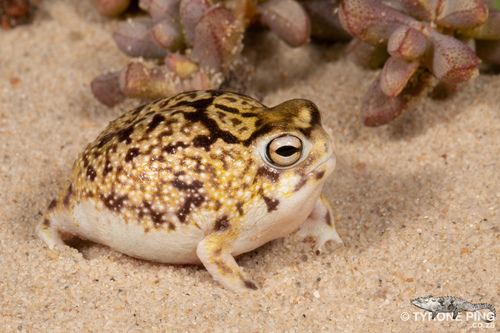
Desert Rain Frog
The Desert Rain Frog, Breviceps macrops, enchants with its plump appearance and unique habitat in Namibia's sandy deserts. Famous for its comical squeaking call, this nocturnal amphibian plays a crucial role in controlling insect populations. Its large eyes and burrowing lifestyle make it a fascinating desert dweller.
2-15 years
Lifespan
11.34 g
Weight
Length: 5 - 6 cm
Size
Yellow, Light-Brown
Color
Near Threatened
Conservation Status
Unknown
Population Trend
Characteristics
Breviceps macrops, also known as the Desert Rain Frog, is a small burrowing amphibian notable for its spherical body, short limbs, and large eyes. It inhabits the arid coastal regions of Namibia and South Africa. Known for its distinctive high-pitched squeak, it thrives in sandy environments, often emerging at night to feed on insects.
Distribution Range of the Desert Rain Frog
Breviceps macrops, commonly known as the Western Desert Rain Frog, is native to the arid regions of southwestern Africa, specifically found in the coastal areas of Namibia and the northwestern part of South Africa.
Desert Rain Frog's Habitat
Environmental Conditions
Breviceps macrops inhabits sandy deserts and coastal dunes, which are characterized by extremely low rainfall and high temperatures. The region experiences a semi-arid climate with highly variable temperatures between day and night.
Ecological Niche
This species is adapted to a fossorial lifestyle, spending much of its time burrowed underground to escape the harsh surface conditions. It prefers areas with loose, sandy soils that facilitate digging. The Western Desert Rain Frog emerges primarily at night or during cooler, misty mornings to feed on small invertebrates. It has a unique adaptation to absorb moisture from the sand, which helps it survive in its arid habitat.
Copyright @ Nature Style Limited. All Rights Reserved.
 English
English